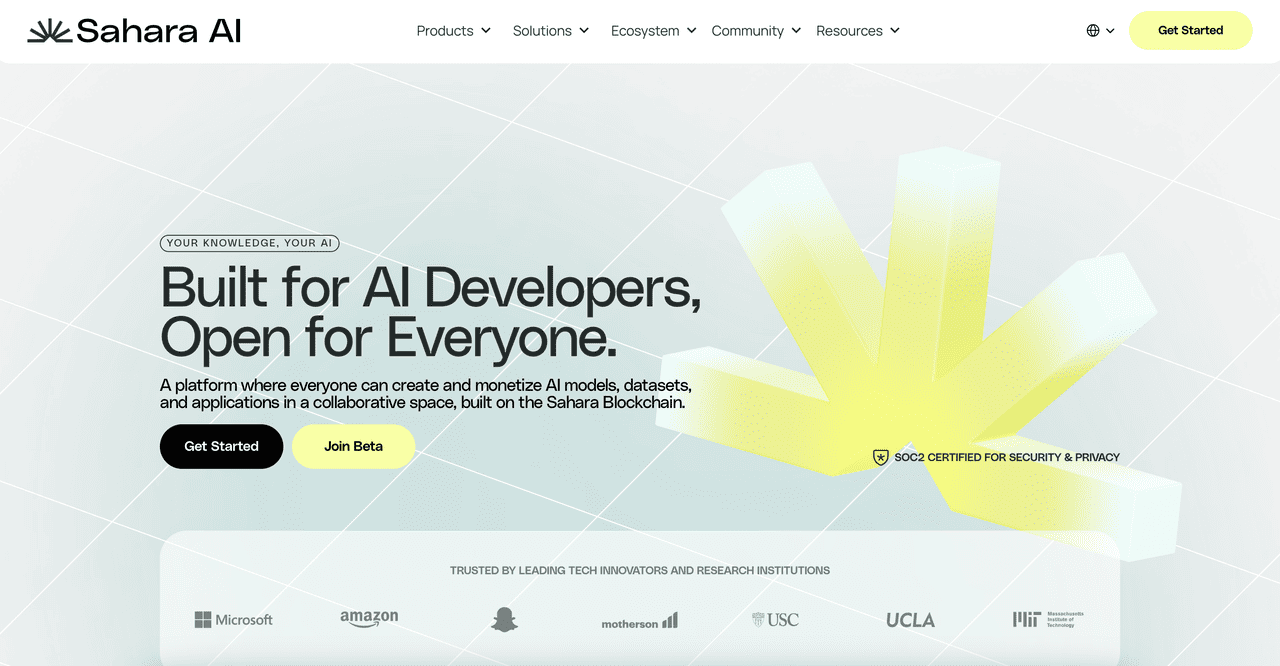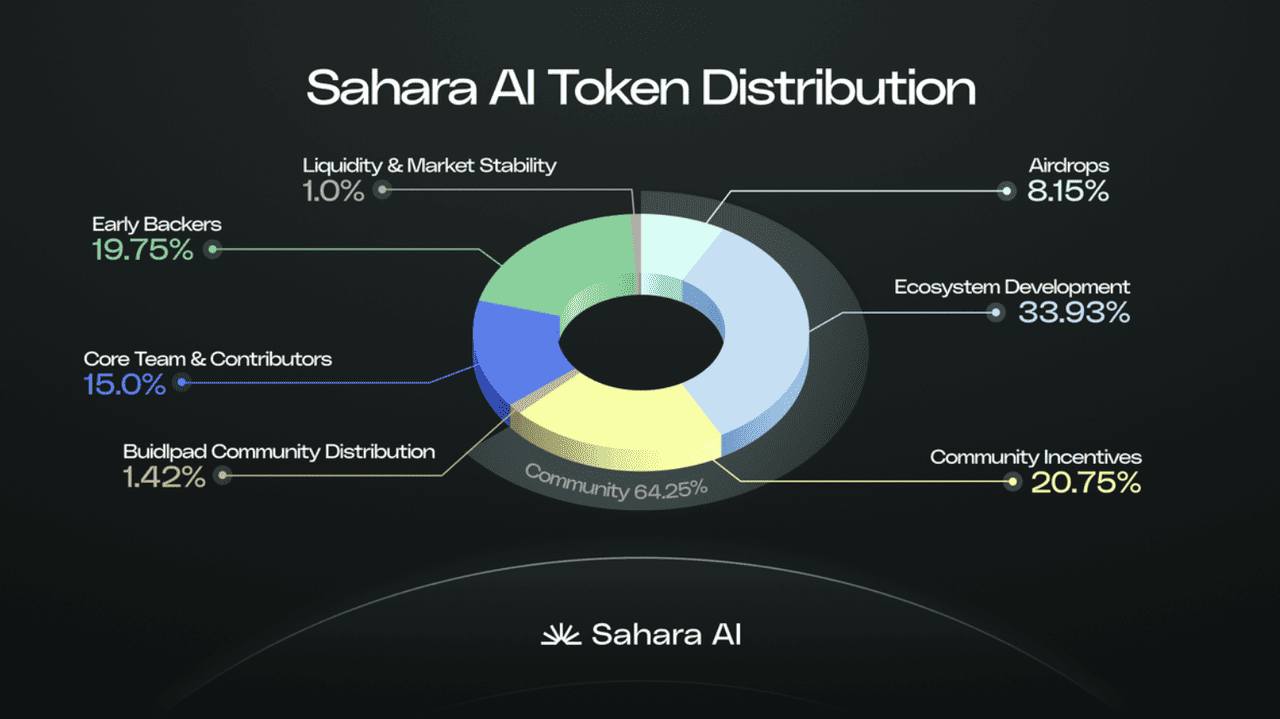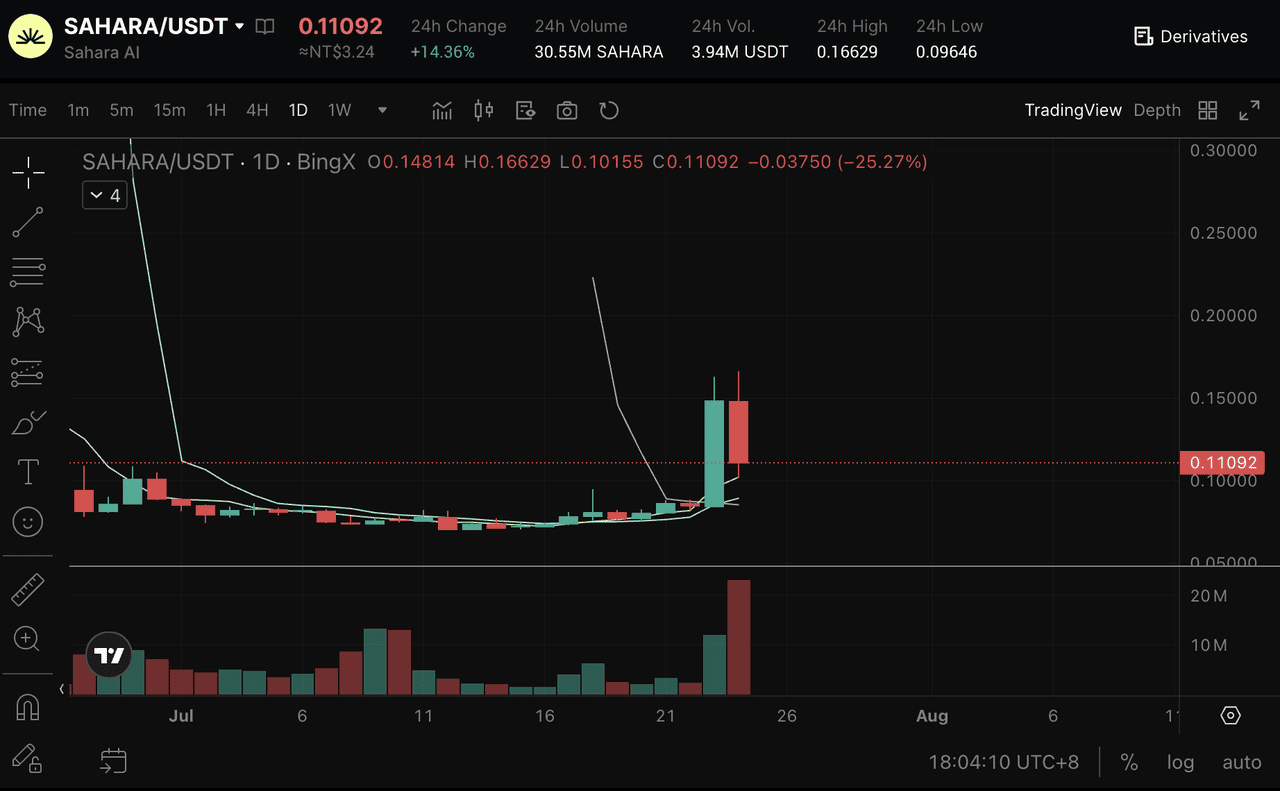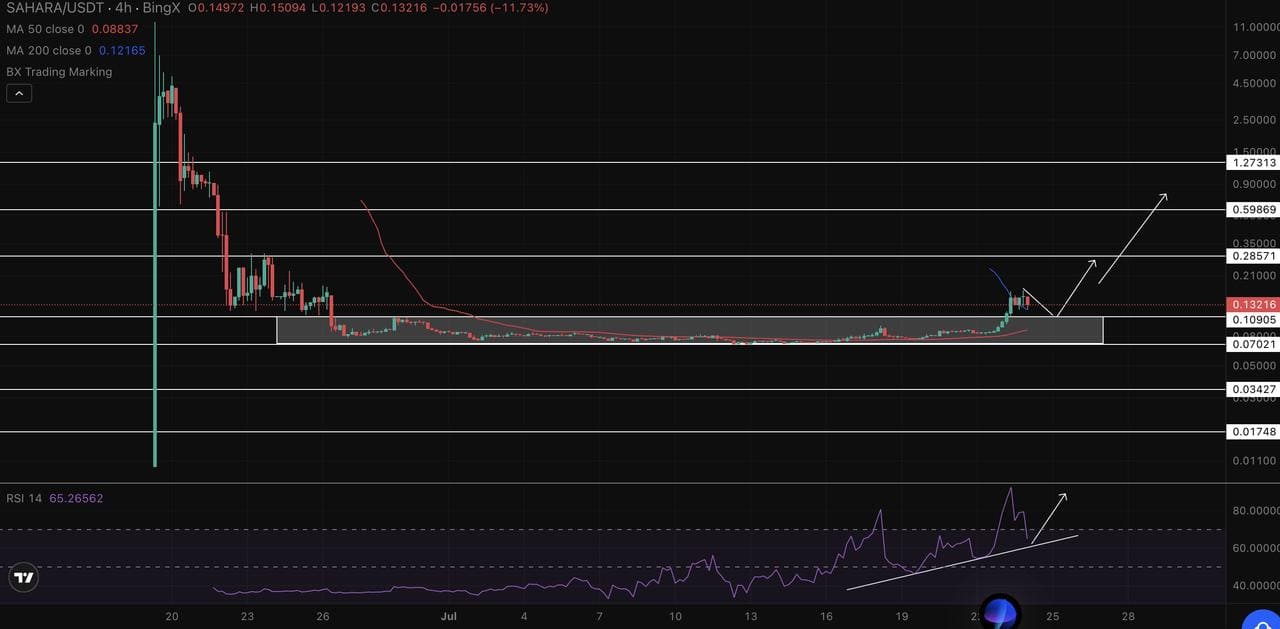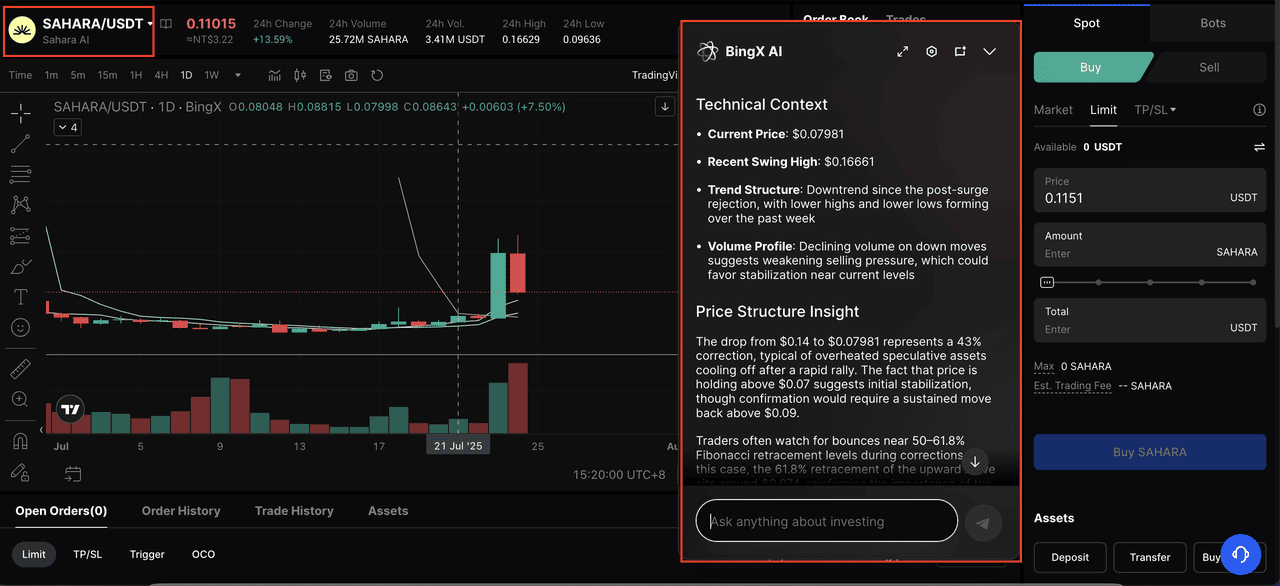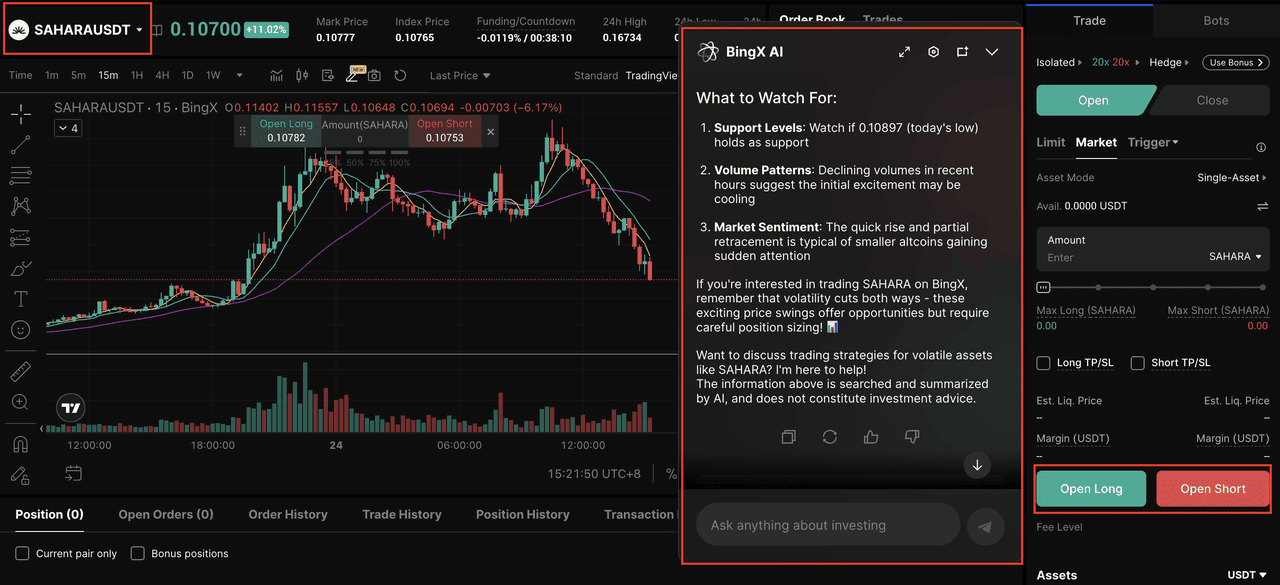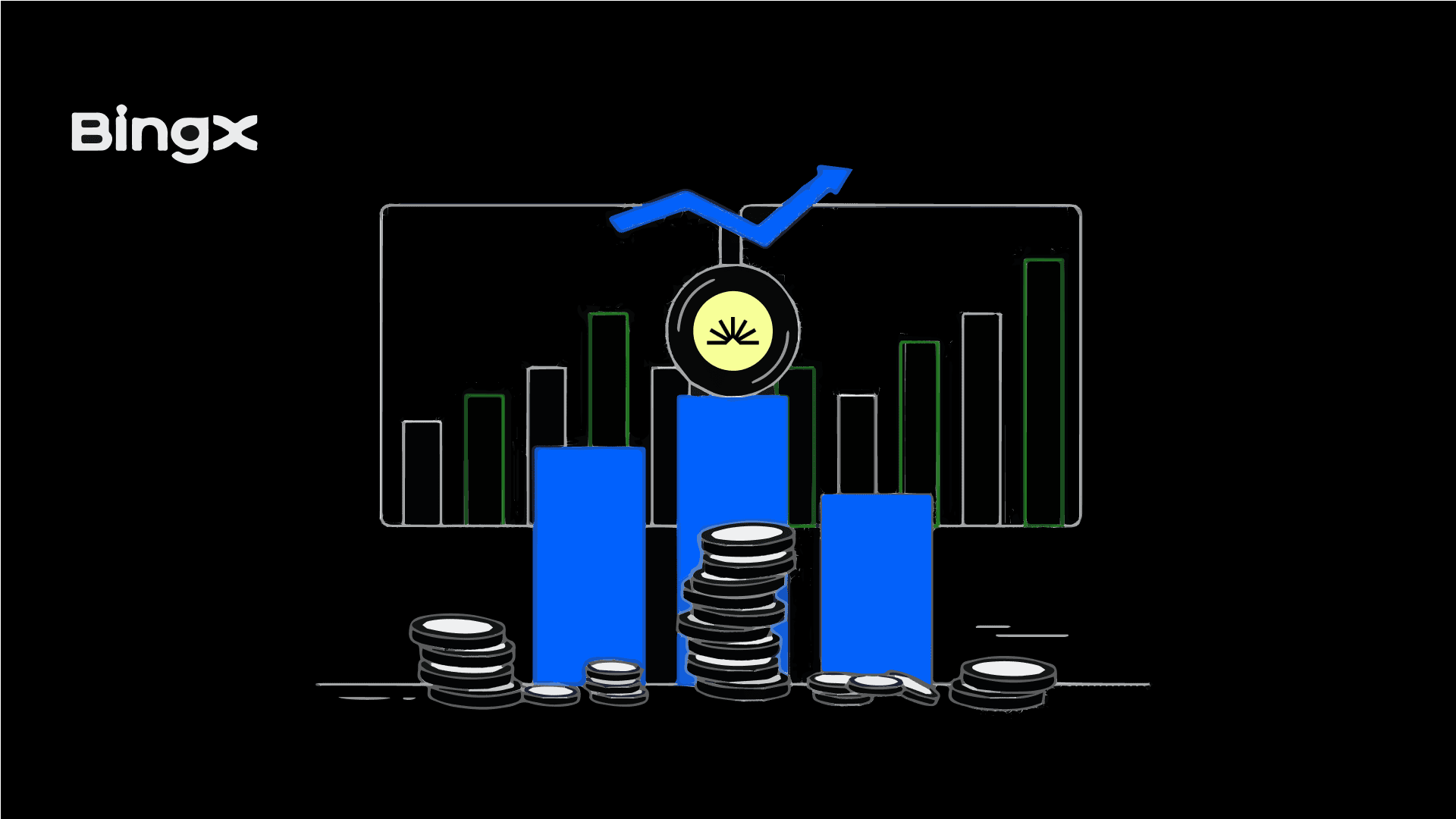Sahara AI (SAHARA), a decentralized AI infrastructure platform, is gaining serious momentum. In just seven days, the SAHARA token surged over 60%, with a 24-hour trading volume spike of more than 1900%, briefly reaching 0.16 US dollars before stabilizing around 0.13. Its
market cap now stands above 260 million dollars, fueled by renewed excitement around the July 22 launch of its Data Services Platform (DSP). This marks a key turning point for the project, shifting attention from narrative hype to actual platform usage.
SAHARA launched in June 2025 at 0.12 dollars through an Initial DEX Offering (IDO) on Buidlpad. After briefly climbing to 0.21, the token corrected to below 0.09. Now, with the DSP live and contributor activity picking up, some investors view the latest rally as a sign that utility-driven demand may be forming, while others remain cautious given the broader
altcoin season market volatility.
As the ecosystem expands, one question stands out:
Could SAHARA break 1 dollar by the end of 2025? In this article, we’ll explore what Sahara AI is, how the SAHARA token works, its
tokenomics and utility, the key price drivers behind its growth, and how to use
BingX AI to trade smarter and stay ahead in a fast-moving market.
What Is Sahara AI and How Does It Work?
Sahara AI is a full-stack decentralized platform that combines
blockchain infrastructure with artificial intelligence. Its core mission is to make
AI systems more open, traceable, and community-owned. Instead of centralizing data and model ownership in the hands of a few corporations, Sahara gives users the tools to upload data, train models, and earn rewards for their contributions.
At the heart of the ecosystem is the Sahara Blockchain, a custom Layer 1 chain built specifically to support AI workflows. It powers every step of the AI lifecycle, from dataset registration to model licensing and on-chain revenue sharing.
Sahara AI is structured around three core products:
• Data Services Platform (DSP): A user-facing portal where contributors complete data-labeling tasks like image tagging or audio transcription in exchange for token rewards. It transforms the often-overlooked process of AI training into a decentralized, reward-driven economy.
• AI Developer Platform: A suite of tools for uploading datasets, fine-tuning models, building AI pipelines, and deploying
AI agents. It supports both no-code and advanced developer workflows.
• AI Marketplace (coming soon): A decentralized exchange for AI assets, including models, datasets, and intelligent agents. All usage is tracked on-chain, and creators receive royalties when their work is used.
The platform already supports over 200,000 contributors, 35 enterprise partners, and millions of data annotations. Its network of collaborators includes names like Microsoft, AWS, Google Cloud, Together AI, and MIT, helping bridge real-world infrastructure with decentralized AI development.
By combining crypto-native incentives with a transparent AI framework, Sahara is building an ecosystem where anyone, not just corporations, can own, train, and profit from AI.
What Is the SAHARA Tokenomics?
SAHARA has a fixed total supply of 1 billion tokens, launched through an Initial DEX Offering (IDO) on Buidlpad in June 2025. Only 1.4167% (14.2 million tokens) were sold at 0.12 US dollars, raising 8.5 million dollars from over 100,000 participants.
The token is allocated as follows:
1. Community-focused allocations: 64.25% (642.5 million) Dedicated to growing the ecosystem and rewarding participation through:
• Airdrops: 8.15% for early contributors and supporters
• Ecosystem development: 33.93% for grants, infrastructure, and innovation
• Community incentives: 20.75% for user rewards and grassroots expansion
2. Core team and contributors: 15.00% (150 million) Locked for 12 months, then vested monthly over 36 months
3. Early backers: 19.75% (197.5 million) For strategic supporters during Sahara’s early development
4. Liquidity and market stability: 1.00% (10 million) Reserved for liquidity provisioning and smooth trading
Most tokens follow a four-year vesting schedule with a one-year cliff. A portion unlocked at TGE to support initial platform use and ecosystem liquidity.
What Makes SAHARA Price Surge in July 2025?
SAHARA's strong rebound in July 2025 followed the public launch of its Data Services Platform (DSP) on July 22. Within 24 hours, the token jumped over 86%, marking one of its most significant single-day moves since listing. The launch introduced real product utility, which may have helped shift attention from speculation to actual platform usage.
Several factors may have played a role in the price recovery:
• Utility came online: The DSP rollout allowed users to earn SAHARA by completing tasks like image tagging and text evaluation. This could have contributed to renewed demand from active participants.
• Increased trading activity: Trading volume rose sharply, and the token briefly touched 0.16 US dollars. This uptick may reflect a return of short-term interest in
AI-related tokens.
• Visible feedback loop: SAHARA now connects directly to platform engagement, where more contributors potentially generate more data, which in turn could increase demand for the token.
• Familiar incentive model: Sahara’s reward structure resembles systems used by projects like Immunefi and Gitcoin. That comparison may have appealed to users familiar with crypto-native bounty ecosystems.
While these signals point to rising interest, it’s still early days for Sahara AI. Market sentiment remains reactive, and the token’s long-term performance will likely hinge on continued user participation, successful governance rollout, and sustained platform activity. For those looking to get involved early, the airdrop campaign is still ongoing, offering a chance to earn $SAHARA by contributing to the testnet and climbing the leaderboard.
Could the SAHARA Token Hit $1 in 2025? Key Support and Resistance Level
Sahara AI (
SAHARA/USDT) recently broke out of a long sideways trading range between $0.070 and $0.1090. After weeks of slow movement, the price suddenly surged with a big green candle, reaching as high as $0.15094. Although it gave back some of those gains quickly, the breakout shows strong buying interest.
Now, the price is trading above its 200-period moving average on the 4-hour chart—an early sign that the trend could be turning upward. The
Relative Strength Index (RSI), which measures momentum, is also rising and currently sits around 62. That suggests the price still has room to climb before becoming “overbought.”
The recent price action shows a healthy pullback just above the old resistance zone, which is now acting as support. If the price holds around $0.121 or pulls back near the 50-
EMA (currently at $0.088), it could bounce again. Look out for strong bullish candles like a
Morning Star or
Bullish Engulfing pattern near $0.1090—these are signs buyers are stepping in again.
If the price breaks above $0.21 with strong volume, it could open the door to the next targets at $0.2857 and $0.5986. If momentum continues in the coming months, reaching $1 or even $1.27 in 2025 is possible.
Support and Resistance Summary for SAHARA/USDT
Support Levels:
• $0.1090 – Key breakout level, now acting as support
• $0.0702 – Previous consolidation base
Resistance Levels:
• $0.2857 – First major resistance if the uptrend continues
• $0.5986 – Mid-level target based on past price zones
• $1.2731 – Long-term resistance and possible 2025 target
How to Trade SAHARA Smarter with BingX AI
Whether you're buying SAHARA on dips, trading short-term momentum, or following experienced traders, BingX gives you flexible options to match your style. With
BingX AI integrated into the platform, you can access real-time insights to make more informed decisions across spot trading and futures trading.
Spot Trading: Build Your Position with AI Support
If you're looking to buy and hold SAHARA or enter during dips, the
spot market is a good starting point.
Step 1: Go to the Spot section and search for SAHARA/USDT.
Step 2: On the trading chart, click the AI icon to activate BingX AI.
Step 3: The tool will analyze price action, highlight support and resistance levels, and detect patterns such as
breakouts or reversals.
For example, if SAHARA is trading near 0.13 but BingX AI identifies a strong support zone at 0.12, you might plan a limit order accordingly instead of chasing a spike.
Futures Trading: Trade Short-Term Volatility with Confidence
Step 1: Search for SAHARA/USDT perpetual in the Futures section.
Step 2: Use the AI icon on the chart to access market intelligence.
Step 3: BingX AI helps track trend strength, momentum shifts, and volatility levels so you can better time entries and exits.
You can also ask BingX AI to analyze your perpetual position and adjust your take-profit or set tighter stop-losses to manage risk.
Final Thoughts
Sahara AI is positioning itself as one of the most ambitious projects at the intersection of blockchain and artificial intelligence. With the launch of its Data Services Platform, a growing contributor base, and a clear token utility model, SAHARA is beginning to shift from narrative hype to real user adoption.
While price volatility remains, the fundamentals are taking shape. If ecosystem growth continues and utility deepens through staking, governance, and marketplace activity, the case for long-term value becomes stronger.
For traders, the SAHARA token offers both opportunity and complexity. This is where tools like BingX AI are especially useful, helping you decode sentiment shifts, identify key levels, and trade with better timing across spot, futures, and copy trading strategies.
As 2025 unfolds, SAHARA will be a token to watch. Whether it reaches one dollar or not, its trajectory is increasingly being shaped by real usage, not just speculation.
Related Reading
